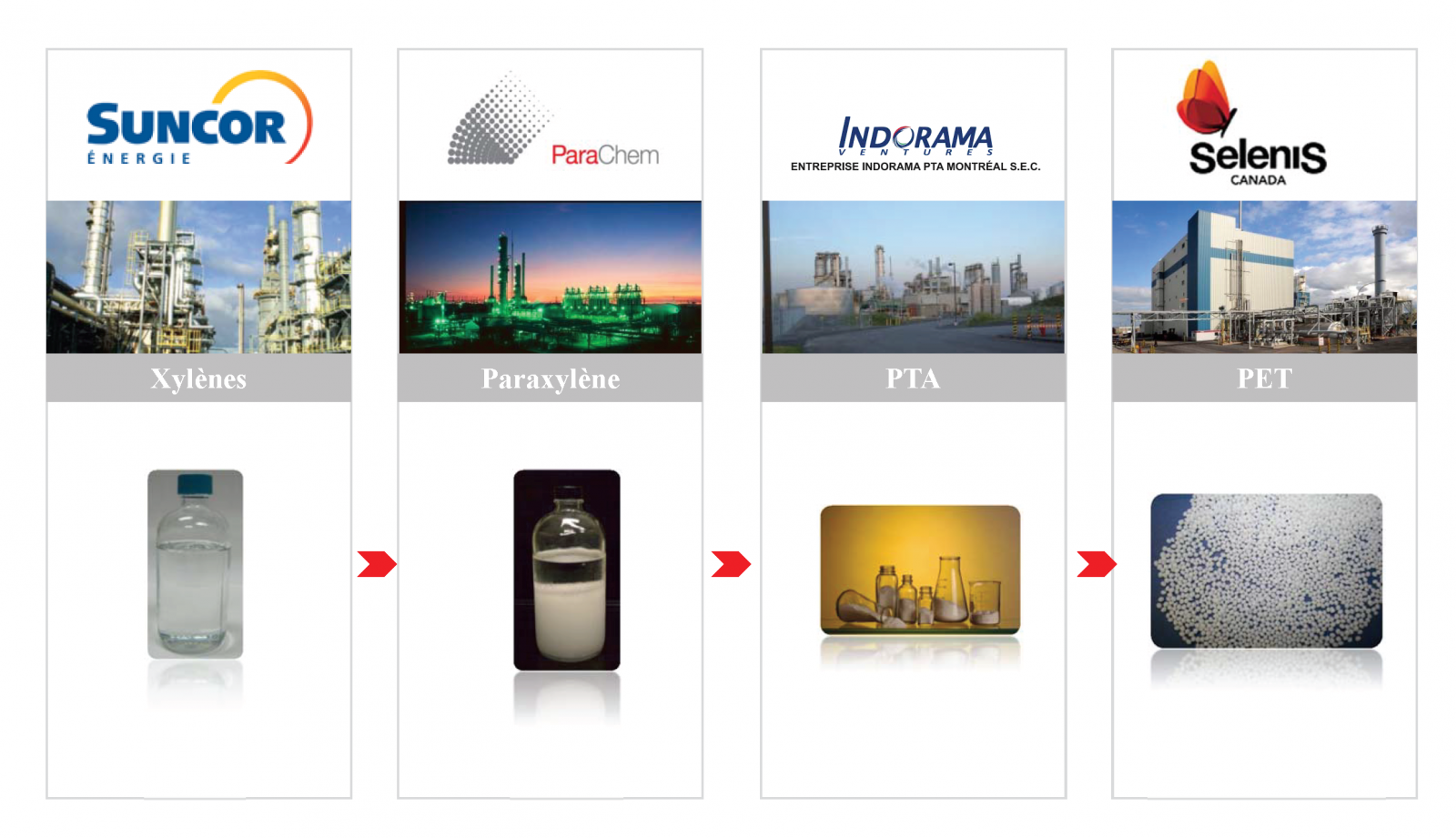ParaChem - Canada's Only p-Xylene Plant
- Site
- Chimie Parachem
Description
Located on the former site of Montreal’s Gulf Refinery, Chimie ParaChem’s para-xylene facility was established in 1994. The plant produces approximately 350,000 tonnes per year of p-xylene, supplying about 8 % of North American demand and roughly 1 % of global consumption.
Chimie ParaChem constitutes the second link in the so-called “polyester chain,” a notable example of industrial symbiosis in eastern Montreal. Within this network, Suncor’s Montreal refinery produces mixed xylenes, which are separated and converted into p-xylene at ParaChem. The resulting p-xylene was historically supplied to Indorama’s (now-closed) purified terephthalic acid (PTA) plant, and the PTA was subsequently processed by Alpek Polyester into polyester fibers and resins. These four facilities were located within close proximity in Montreal East, forming one of the most integrated petrochemical value chains in Canada.
The process units were originally installed in Puerto Rico at the Phillips Puerto Rico Core site, operated by Phillips Petroleum Company (now Chevron Phillips Chemical Company). In the early 1990s, the units (naphta reforming process) were dismantled and transported to Montréal, where they were reassembled piece by piece. During the 1980s, Phillips Petroleum faced significant financial difficulties and divested several assets to avoid bankruptcy.
The company is now shared by Suncor Energy (51%) and Investissement Québec (49%). The plant’s history reflects the cyclical nature of the petrochemical industry : Kemtec encountered financial difficulties and suspended operations between September 1991 and October 1994. At the time, the facility included naphtha desulfurization and reforming units producing approximately 181,000 t/y of para-xylene (p-xylene), 28,000 t/y of phenols, and 11,500 t/y of acetone. During the Gulf War (1990–1991), the U.S. military requisitioned large volumes of naphtha for jet fuel blending, causing a sharp increase in feedstock prices. As a result, p-xylene production became unprofitable for Kemtec, who used naphta as a starting point. Operations resumed in 1994, when Coastal Petrochemicals acquired the site and implemented a more modern process that used toluene and mixed xylenes as feedstocks instead of the straight-run naphtha (Mobil's Sensitive Toluene Disproportionation Process, or MSTDP, coupled with xylenes isomerization and p-xylene cristallisation).
Regarding p-xylene margins and market structure, Chevron Phillips Chemical Company describes the sector as follows:
« A few very large global consumers buy most of the paraxylene available in the market. They purchase mainly on a term contract basis with pricing tied to a quarterly negotiated, industry-wide contract price. With the purchasing concentrated in a few large consumers, these large consumers are able to exert pressure on the quarterly negotiated contract price, which means that low margins result during times of oversupply. There is also an active spot market for paraxylene, which allows large consumers a degree of flexibility with respect to pricing options and the periodic need to cut back production for inventory control. » (Chevron Phillips Chemical Company LLC, 2002, p. 14)
The plant was shut down again on January 1, 1999 due to low p-xylene prices and remained idle until 2003. During this period, air-quality measurements in Montreal East indicated reduced benzene concentrations. Production resumed May 1, 2003 following new investments by the Investissement Québec and Coastal. The name Chimie ParaChem was adopted in 2006, one year after Petro-Canada (now Suncor Energy) acquired Coastal’s operations. It has been speculated that the name of the present entity, Chimie ParaChem, might have been inspired by the plant’s origin, linked to Chevron Phillips Chemical (CPChem). However, this connection remains unconfirmed. In 2017, a 10-tonne-per-day carbon dioxide capture unit, developed by Saipem, was installed and successfully tested on the p-xylene process line, representing a milestone in the site’s efforts to reduce its carbon footprint. Following the closure of Indorama’s PTA plant in 2024, Chimie ParaChem continued operating but was compelled to lay off 37 employees due to reduced downstream demand. Operations are still ongoing.
Process
Input : Toluene, Natural Gas, Xylenes (all isomers).
Output : Benzene, C9+, H2, p-Xylene, CO2.
Units : p-Xylene unit (cristallisation, isomerization), MSTDP unit (transforms toluene into a 80% proportion of p-xylene, rest is meta and ortho isomers), Hydrogen unit (steam reforming), Utilities.
Mobil MSTDP seems to be in use at ParaChem.
Galery

(Brunelle, 2000).
The four original constituants of the PET chain

(AIEM, 2025)
Mediagraphy
AIEM. (2025). Chaîne du PET. [Image]. https://aiem.ca/nos-membres/profil-industriel/chaine-du-pet
Brunelle, A. (2000). La nature des productions et des matières premières de Coastal. Letter to Louison Fortin. https://voute.bape.gouv.qc.ca/dl/?id=00000112797
BAPE. (2001). Projet d’usine d’acide téréphtalique purifié à Montréal-Est par Interquisa Canada inc. Report of investigation and public hearing. https://archives.bape.gouv.qc.ca/sections/rapports/publications/bape146.pdf
Bibeault, J.F., Jourdain, A. (1995). Synthèse des connaissances sur les aspects socio-économiques du secteur d'étude Montréal-Longueil. Rapport technique. Centre Saint-Laurent de Conservation de l'Environnement, Environnement Canada.
Carter, A.-M., Germain, A. (2006). Tracking Benzene and Organic Volatile Organic Compounds in the Ambient Air in Montreal's East End - 1989 - 2004. Environmental Protection Operations Division, Environnement Canada. https://publications.gc.ca/collections/collection_2016/eccc/En154-44-2006-eng.pdf
Chevron Phillips Chemical Company LLC. (2002). Form S-4 Registration Statement – Paraxylene Market Overview [Corporate filing]. U.S. Securities and Exchange Commission.
https://www.sec.gov/Archives/edgar/data/1137293/000091205702030136/a2084101zs-4.htm
Doyle, J. (2019, July 30). The Phillips explosion – Pasadena, TX: 1989. PopHistoryDig. https://pophistorydig.com/topics/the-phillips-explosion-pasadena-tx-1989/
Le Nouvelliste. (1991, 6 mars). Le Nouvelliste (71ᵉ année, no 105). Trois-Rivières, Québec : Imprimeries Le Nouvelliste Ltée. https://numerique.banq.qc.ca/patrimoine/details/52327/
ParaChem. (2025). Notre histoire. http://www.parachem.ca/
Ferrere, C., Gingras, J., Madore, E., Gentilucci, S., Surprenant, R., Fradette, S. (2024). Performance of a 30-ton-per-day CO2 capture plant using the CO2 Solutions by Saipem technology. 17th International Conference on Greenhouse Gas Control Technologies, GHGT-17 20th-24th October 2024 Calgary, Canada. https://ssrn.com/abstract=5059334
Okalla Bana, E.-C. (2014). The Quebec leader for consulting engineering: SNCLavalin (1911-1991). Revue française d'histoire économique, 1, 108-127. DOI 10.3917/rfhe.001.0108
|
Braun, Uwe
10/27/2025 6:28 AM
Great Article Jacob. Interestingly the PFD cannot be viewed from my location. Can you send me please a screenshot, how it shoud look like? Email: uwe.braun@portfolio-pplus.com Possibly we can re-create it, using our Mass Balance and Visualization - Tools. You may notice, we have released the updated version. Now "Insights" like these can be done for Entities (Companies), Technologies and Products. |







